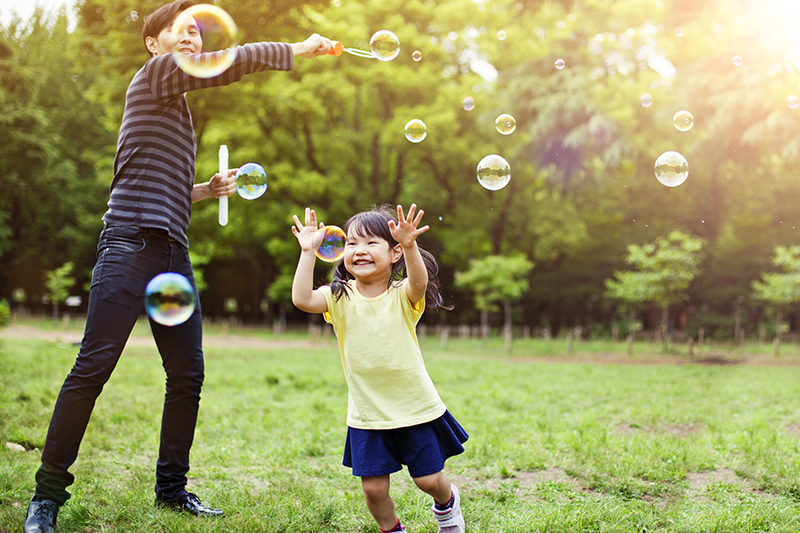Families For Life | Physical Activity for Younger Children-Newborn

Daily physical activity is good for young children in so many ways. Getting your child moving is easy when you make activity fun and part of your child’s play.
Daily physical activity: Focusing on fun
When you’re choosing physical activity for babies, toddlers and pre-schoolers, focus on activities that are fun.
If children enjoy what they’re doing, they’re more likely to want to keep doing it. And all the activities children enjoy increase their ability to move well.
Physical activity can just be part of your child’s everyday play and can start very early in life.
Physical activity for children 0-2 years
Babies aged 0-12 months need plenty of opportunities for free movement, as long as they can do it in a safe environment. An environment that encourages your child to explore and develop skills like reaching, rolling, sitting up, crawling, pulling up and walking is great. This can be inside or outside.
Before baby can walk
Even tiny babies like to stretch and play. A large blanket on the floor (or on the grass outside) for ‘tummy time’ can be a safe, clean and welcoming place for babies to practise lifting their heads. This helps them develop strong muscles.
A blanket on the ground or floor is also a great place for baby to learn to roll, creep, crawl and sit. If you put a toy or object just out of reach, it encourages your baby to make an extra effort to reach it. This can help physical development.
Great low-cost tummy time toys include things to grab and hold like old boxes. Another idea is plastic containers with things that rattle inside. The lid needs to be on very tight so baby can’t get to the little things inside. Bright colours, drawings of dots or squares or stars, shiny surfaces, changing textures and different sounds can also interest your child.
You can also encourage baby to look, clap, reach or move to sound – try singing, rhyming or action games (like pat-a-cake and peekaboo) and talking.
If you’re putting baby on the floor, just remember to take a look for potential hazards down at baby’s level. Stay with your baby to keep things safe.
When baby starts to walk
Once your child is walking, you can encourage her just by letting her move often. This means plenty of time out of the pram.
This is a great time to look for objects and activities that encourage movement. For example, when you help your child climb a slide at the playground, you’re building self-confidence and balance. You’re also paving the way for your child to climb stairs.
Playing with your child and praising him as he learns to run, jump, dance and throw encourages him to keep going.
Physical activity for children 2-5 years
Toddlers and preschoolers need plenty of time to just run around and play. Backyards, school playgrounds, empty sporting fields, adventure playgrounds, school playgrounds, parks, trails and the beach are all great places for children of this age.
Here are some ideas for keeping physical activity fun:
You can use a large, soft ball to practise catching, hitting, bouncing and kicking.
Throwing can start with something small and easy to hold like a little bean bag or tennis ball. When spaces aren’t safe for balls, an old pair of socks can be good for this.
You can get your child to chase bubbles, walk along chalk lines and jump over cracks in the ground or puddles.
Playing different music, or making sounds with your voice or instruments, can encourage dancing and a sense of rhythm.
Invent some silly walks and runs with your child – try running like a monkey, jumping like a bunny and flapping like a bird.
Your child might enjoy learning to ride a bicycle, scooter or tricycle – under your supervision, of course – and playing with push toys like trucks, doll prams and toy lawn mowers.
You could make up games that involve rolling, jumping, dancing and chasing.
Leave the car at home sometimes and try walking to places like the library, park or shops. If you’re feeling really adventurous, you could even go without the pram.
Organised physical activity and sport
When is the right time to sign your child up for organised sport? When your child is ready is the simple answer.
If your younger child is interested in organised sport, it might be worth looking for an organised non-competitive sport. Other options could be gymnastics, swimming or soccer.
With modified and junior sports, the focus is usually on developing skills and getting everyone to have a go. That’s because there’s no need to pressure young children about perfect technique, or winning and losing. It’s more important for them to learn about the fun of playing, being active and trying hard.
Children are generally ready for organised competitive sport at the age of 8-10 years. This is when most children understand the value of fair play and are ready to cope with winning and losing.
If you think your child is ready for organised sport, you could talk to other parents about sports clubs and programmes in your area. Also talk to people at the club and even the coach for your child’s age group. Go along and watch other children playing the sport. A sign of a good programme is children having fun.
Toddlers and pre-schoolers should be physically active every day for at least three hours, spread throughout the day.
Outdoor Play
Outdoor activities and sunlight can help in reducing myopia in your child. Outdoor play also helps your child to be active and learn about social interaction and cooperation when playing with others.
© raisingchildren.net.au, translated and adapted with permission
Explore more